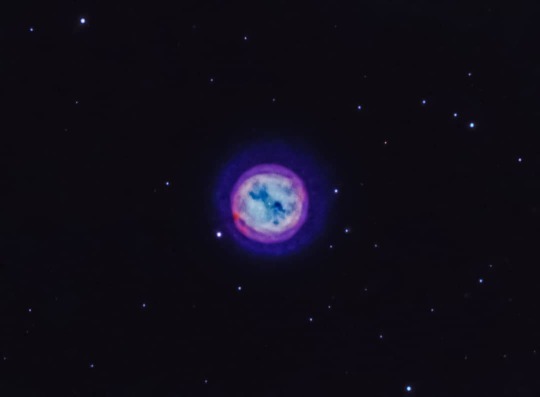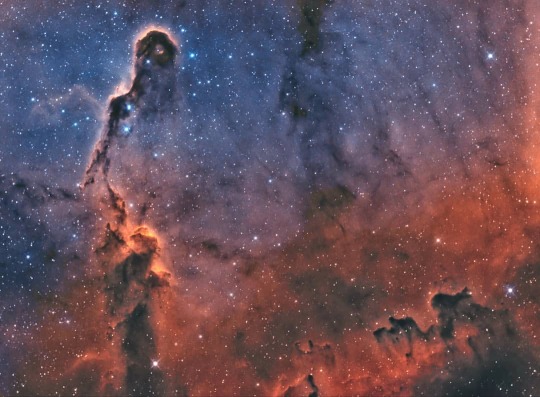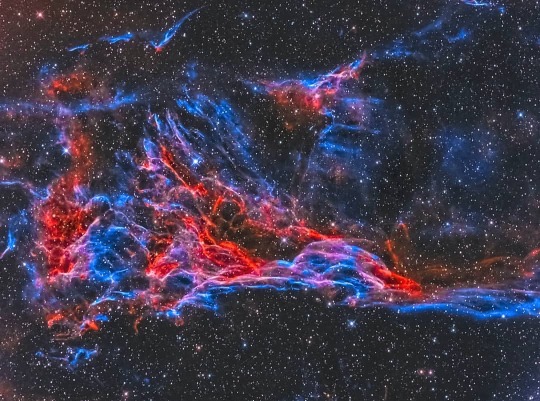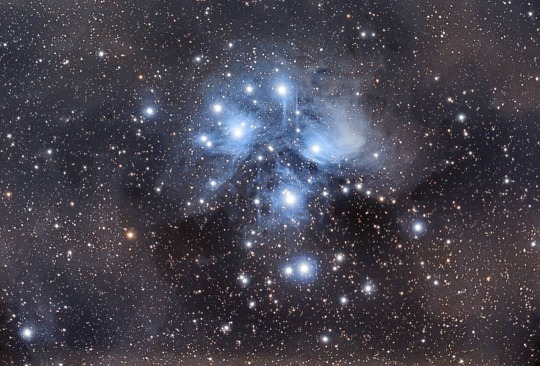Amateur astrophotographer from Fort Worth Texas USA. images taken by me with various astro setups. On IG as @gorilla_astro. bringing home a piece of the sky from me to you #astronomy #astrophotography #cosmos #space #stars #nebula #galaxies #milkyway #longexposure #nightphotography #texas
Don't wanna be here? Send us removal request.
Photo

M97 the owl nebula Hoot hoot! (Swipe to see a barn owl I found) The Owl Nebula (also known as Messier 97, M97 or NGC 3587) is a planetary nebula located approximately 2,030 light years away in the constellation Ursa Major. The nebula is approximately 8,000 years old. It is approximately circular in cross-section with a little visible internal structure. It was formed from the outflow of material from the stellar wind of the central star as it evolved along the asymptotic giant branch. The nebula is arranged in three concentric shells, with the outermost shell being about 20–30% larger than the inner shell. The owl-like appearance of the nebula is the result of an inner shell that is not circularly symmetric, but instead forms a barrel-like structure aligned at an angle of 45° to the line of sight. I'd also like to add that if you love owls and haven't seen it then you should buy the documentary "owl power" on prime video. Well worth it! My son and I have watched it well over 300 times. Equipment: Gso rc6 with astrophysics ccdtv 67 spaced for .72x focal reduction, qhy polemaster, zwo asi290mm mini, zwo asi1600mm cool, zwo efw8 using 1.25" filters, hydrogwn alpha filter at 5nm and oxygen 3 filter at 3nm, stellardrive heq5, modified zwo off axis guider. Data: Hydrogen alpha: 75x5min (6hr 15min) Oxygen III: 77x5min (6hr 25min) Total integration: 12hr 40min Software: Sequence generator pro, phd2, eqmod, polemaster, stellarium, pixinsight, and light room. Most of the above mentioned gear (except stellardrive heq5) can be found at optcorp via my affiliate link http://bit.ly/32ahgqc #OPTeam #optcorp #asiweek #space #cosmos #owls #barnowl #nebulae https://www.instagram.com/p/CAOw0V7n7il/?igshid=emvszzt3b5id
1 note
·
View note
Photo

Space tadpoles A nice fun crop edit I did today while staying in the house during these times. Hope y'all are keeping it real out there! Been a while since I've made any new because of clouds and rain but anywho! Follow @gorilla_astro on IG for more of my ground based Astrophotography IC410 is a dusty emission nebula located in the constellation of Auriga at about 12,000 light years from Earth. It is part of a larger star forming region that also contains the Flaming Star Nebula. The gas structures in this picture are lit by the radiation from the open star cluster NGC1893 that lies in the center of the nebula. This star cluster is about 4 million years old, but in astronomical terms it is still very young, with hot, massive stars. As can be seen in the picture, these structures point away from the center of the nebula. This is because of the stellar winds and radiation pressure from the stars in NGC 1893. Due to these structure's shape, the nebula is also called the Tadpoles Nebula. Data: Halpha 144x360s. (14 hr 24min) Oiii 71x600s. (11hr 50min) Total integration time: 26hr 14min Equipment and software: gso rc6, astrophysics ccdt67, stellardrive heq5 mount, self modified zwo off axis guider with asi290 mini, imaged with an asi1600mm using astrodon filters 3nm oiii and 5nm halpha. Qhy polemaster. Software on the field: sgp, eqmod, stellarium, phd2, plate solve 2. Calibrated, aligned, integrated, and finalized in pixinsight. Thank you for looking and always keep your head up to the stars! #longexposure_shots #nightshooterz #opteam #deepspace #cosmos #astrophotography #woahdude #astronomy #stargazing #optcorp https://www.instagram.com/p/B-S0JubplNq/?igshid=11onr670z4s89
#longexposure_shots#nightshooterz#opteam#deepspace#cosmos#astrophotography#woahdude#astronomy#stargazing#optcorp
0 notes
Photo

California nebula in a more vibrant edit. Which one do you like better? Follow @gorilla_astro for more sky pieces Been rather slow on my end with the weather and more so I decided to revisit this to see how much more I could bring out without over processing the overall image. If you haven't seen the original it's the second image to look at. This was done in narrowband so I was able to capture it's elemental composition even in the severe light pollution Data: Gain 200 207x3min halpha. (10hr 21min) -10c bortle 7 83x10min oiii (13hr 15min) -20c bortle 5.5 44x10min sii (7hr 20min) -20c bortle 7 Total integration: 30hr 56min Equipment: spacecat 51, asi1600mm cool, efw8, stellardrive heq5, asi290mm mini, 30mm mini guidescope, astrodon 5nm halpha, 3nm oiii, 5nm sii all "1.25 sized. Qhy polemaster Software: Eqmod, pixinsight, sgpro, phd2, stellarium, polemaster, plate solve 2 #astrophotography #astro #astronomy #coronavirus #california #nebula #stars #asiweek #optcorp https://www.instagram.com/p/B9kJgO_pznH/?igshid=wxz9zej9ywz7
0 notes
Photo

Elephants trunk in bicolor (IC 1396/vdb 142) This is an emission nebula about 2400 light years away. Located in the constellation cepheus, it is comprised of dense interstellar gas and dust with a large structure of ionized dust and a diffuse nebula. The elephants trunk nebula is thought to be a massive star forming region with young stars less than 100k years old! The pressure from the light, gas, dust and star formation is theorized to host a current generation of protostars. Thought i would work a new rendition of the elephants trunk here as i am learning and experimenting with narrowband color palettes. Its one of my favorite star forming regions on my list and i just felt like after looking at the first rendition that it deserved some attention. I decided to see what i could cook up with a bicolor style using the hydrogen alpha and Oxygen III present in the nebula. Equipment and software: Gso rc6, stellardrive heq5, self modified zwo off axis guider, zwo asi1600mm with 8 position electronic filter wheel using astrodon filters 3nm oiii, and 5nm halpha. Qhy polemaster Field sofware: sgpro, eqmod, stellarium, phd2 and plate solve 2 Calibrated, aligned, stacked and processed in pixinsight. Data: Halpha 49x600s. Oiii 35x600s Total= 14 hours captured in my backyard bortle 7 (severe) light pollution #space #astrophotography #Optcorp #astrodon #backyardastrophotography #amateurphotography #narrowband #spaceischill #cosmos #night #longexposure #stars #whoadude #starstuff #nebula #universetoday #deepspace #explorespace #amateurastrophotographyezine #OPTeam https://www.instagram.com/p/BrqC90NhZxw/?igshid=1w8h8921a06qc
#space#astrophotography#optcorp#astrodon#backyardastrophotography#amateurphotography#narrowband#spaceischill#cosmos#night#longexposure#stars#whoadude#starstuff#nebula#universetoday#deepspace#explorespace#amateurastrophotographyezine#opteam
0 notes
Photo

Pickerings triangle (cloudy nights reprocess) I like to call this the Pizza Nebula as it looks like a slice of pizza with stretchy cheese. Named for the Harvard professor Edward Charles Pickering. Very interesting fellow to read on by the way. He had a team of only women help map all the stars and determine their measurements, temperatures and distances from each other and the earth. Amongst the women, 2 of them made huge differences in the way we understand the cosmos along with their team. These 2 women were Annie Jump Canon and Cecilia Payne. Cecilia Payne, known amongst scientists gave rise to modern day astrophysics and her studies are the standard text into it. She came from the UK to the USA during a time when women weren't allowed to take advanced studies of the cosmos in her home country. For more information on these great women and Mr. Pickering you can find it online. As for the nebula.... This is but a small portion of the ever expanding veil nebula (aka the cygnus loop) found in the cygnus constellation. The veil is a supernova remnant that exploded 3000 BC to 6000 BC. It now appears as clouds of ionized gas and dust. The distance to the nebula isn't 100% accurately known but the Far Ultraviolet Spectroscopic Exporer supports a distance of 1470 light years away. This was captured with a GSO Rc6, Zwo asi1600mm, 8 position electronic filter wheel, off axis guider with a zwo 290mm mini, astrophysics ccdt67 and a Stellardrive heq5 mount. Software for field work: eqmod, apt, stellarium, phd2 and plate solve 2. Calibrated and processed in pixinsight. Full res link under bio 46x300s halpha 18x600s Oiii 64 darks 30 flats 200 bias As always thanks for looking and always look to the stars #astrophotography #deepspace #nightsky #insta_grag #photography #spaceismetal #longexposure #stars #pixinsight #highpointscientific #universe #night #nightphotography #astronomy #amateurastrophotographyezine #OPTeam #astrodon #yourESA #science #followyourstars #texasphotographer #metal #amateurphotography #nasa #triangle #pizza #milkywaychasers #wintersun @insta_grag https://www.instagram.com/p/BxbAtvwnNQg/?igshid=1n5ayhx9fppky
#astrophotography#deepspace#nightsky#insta_grag#photography#spaceismetal#longexposure#stars#pixinsight#highpointscientific#universe#night#nightphotography#astronomy#amateurastrophotographyezine#opteam#astrodon#youresa#science#followyourstars#texasphotographer#metal#amateurphotography#nasa#triangle#pizza#milkywaychasers#wintersun
0 notes
Photo

Melotte 15 (the sequel) The heart of the heart nebula (ic 1805). Melotte 15 is a star cluster of young "O" type super giant stars at 1.5 million years old and a lovely nebula formed with those stars in an interstellar dance of gravity and radiation bringing ferocious stellar winds to shape the "swirly" nebula you see. Melotte 15 is named after its discoverer Philibert Jacques Melotte. This lovely wonder is located about 7500 light years away. "O" type stars are the brightest and most massive known stars ranging from 20-100x larger than the sun and have a lifespan of 3-6 million years This here is a bicolor rendition of the halpha and oxygen III regions and was shot in my backyard at bortle 7 (severe) light pollution. Data: 122x360s halpha, 100x600s Oiii Total integration= 28hrs 54min Equipment: 🔭Gso rc6, 📷Zwo asi1600mm-c, self modified zwo off axis guider using asi290mm mini for guiding, Stellardive heq5 mount, astrophysics cctd67 reducer, astrodon halpha, and Oiii in an 8 position electronic filter wheel. Qhy polemaster Sensor cooled to -20c Software: Sgpro, phd2, plate solve 2, stellarium, eqmod, and pixinsight. For now and always thanks for looking and always keep your head up to the stars! 🎶🎸🎶 https://www.instagram.com/p/BzCWoXIldP7/?igshid=28fawyqlqvnb
0 notes
Photo

Rising above the flames! The butterfly nebula Looking deep into the Orion arm of our home Galaxy there's a beautiful nebula about 3000 light years from us. This here is the butterfly nebula, a diffuse emmission nebula and a part of a much larger nebula filled with star clusters, gas and dust. Some people call the whole nebula the gamma cygni nebula and some call it the sadr region for the bright foreground star that sits about halfway between us and the nebula itself This here was shot in narrowband in my backyard Fort Worth, tx. Bortle 7 Data: 175x3min halpha (8hr 45 min) 62x5min oiii. (5hr 10min) 84x6min sii (8hr 36min) Total integration: 22hr 31min Equipment: Explore scientific Ed80 Apo triplet with astrotech .8x reducer flattener, stellardrive heq5 mount, Zwo asi1600mm cool set at 200 gain Zwo efw8 using astrodon 5nm ha, 3nm oiii and 5nm sii. Self modified zwo oag using the asi290mm mini. Qhy polemaster. Software: Sgpro, phd2, stellarium, eqmod, and processed in pixinsight Thank you for looking and always keep your head up to the stars https://www.instagram.com/p/B2PD0S-pHol/?igshid=x0shjlzo4ji5
0 notes
Photo

The soul nebula Located in the Perseus arm of our galaxy around 7500 light years away is a beautiful star forming region known as the soul nebula. A neighbor to the heart nebula. Look to the constellation Cassiopeia. Like other massive star-forming regions, such as Orion and Carina, the soul nebula contains large cavities that were carved out by radiation and winds from the region's most massive stars. According to the theory of triggered star formation, the carving out of these cavities pushes gas together, causing it to ignite into successive generations of new stars. Captured in my backyard in Fort Worth Texas Bortle 7 light pollution 281x3min & 122x5min halpha 107x6min oiii Total integration: 34.92 hours Equipment: Explore scientific Ed80 Apo triplet with astrotech .8x reducer flattener, Zwo asi1600mm cool set at 200 gain Zwo efw8 using astrodon 5nm ha, 3nm oiii and 5nm sii. Self modified zwo oag using the asi290mm mini. Qhy polemaster. Software: Sgpro, phd2, stellarium, eqmod, and processed in pixinsight Thank you for looking and always keep your head up to the stars! https://www.instagram.com/p/B3e9eNjFszQ/?igshid=p1st1b3vkrx0
0 notes
Photo

Check it out y'all!! @ak_astro and I are featured on the latest issue of Reflector magazine. Swipe over to see Andrew on the front cover woohoo!! And swipe again to see an accidental close-up of my m33 because Instagram wouldn't give me the option to zoom out for full picture 😂😂😂. The original of my m33 will be found on my gallery and includes an annotated image and an image of just the halpha structures in this magnificent Galaxy. Also will be a nice description if you're brain is hungry for some space facts. Go check it out and show some love 😁 This is so exciting! Thank you to everyone who support and follow my work! First time I've ever had anything related to me in a magazine, so yeah I'm gonna have to pour a dram of my favorite scotch to celebrate! Yeah buddy! Thank you for looking and always keep your head up to the stars! #astrophotography #natgeo #natgeospace #opteam #nasa @universe_view_screen #universetoday #zwo #scotch https://www.instagram.com/p/B3rwEK_gk8M/?igshid=p3x4a0on1vnx
0 notes
Photo

The California nebula About 1000 light-years from earth lies Ngc 1499, an emission nebula located in the constellation Perseus. As you can tell this nebula is aptly named after the usa state that had the #terminator Arnold @schwarzenegger as it's governor, given its shape when placed at this angle. Get to the choppah!!! Find a telescope!!! And get yourself an hbeta filter when visually observing this as its a very faint to view. The object was discovered by E. E. Barnard in 1884. Merely coincidence the california nebula at zenith transits with central California in latitude declination. Perhaps it's a prophecy? Aliens visiting?.... Hmmmm... Nah just kidding 😂 Nyyyaaaaarregghhhhh kaahhlyforghnnnniyyyyggaaahh!!! Hasta la Vista baby. Data: Gain 200 207x3min halpha. (10hr 21min) -10c bortle 7 83x10min oiii (13hr 15min) -20c bortle 5.5 44x10min sii (7hr 20min) -20c bortle 7 Total integration: 30hr 56min Equipment: spacecat 51, asi1600mm cool, efw8, stellardrive heq5, asi290mm mini, 30mm mini guidescope, astrodon 5nm halpha, 3nm oiii, 5nm sii all "1.25 sized. Qhy polemaster Software: Eqmod, pixinsight, sgpro, phd2, stellarium, polemaster, plate solve 2 Thank you for looking and Get to the choppah!!! *Cough cough* always keep your head up to the stars https://www.instagram.com/p/B4tRy70p8cZ/?igshid=1mamvplouwz4d
0 notes
Photo

Are you worthy? NGC 2359 (also known as Thor's Helmet) is an emission nebula in the constellation Canis Major. The nebula is approximately 11.96 thousand light years away and 30 light-years in size. The central star is the Wolf-Rayet star WR7, an extremely hot star thought to be in a brief pre-supernova stage of evolution. It is similar in nature to the Bubble Nebula, but interactions with a nearby large molecular cloud are thought to have contributed to the more complex shape and curved bow-shock structure of Thor's Helmet. 72x6min halpha 60x6min oiii Total integration: 13hrs and 12min Equipment: Gso rc6 with astrophysics ccdtv 67 spaced for .72x focal reduction, qhy polemaster, zwo asi290mm mini, zwo asi1600mm cool, zwo efw8 using 1.25" filters, hydrogwn alpha filter at 5nm and oxygen 3 filter at 3nm, stellardrive heq5, modified zwo off axis guider. Software: Sequence generator pro, phd2, eqmod, polemaster, stellarium, pixinsight, and light room. Most of the above mentioned gear (except stellardrive heq5) can be found at optcorp via my affiliate link http://bit.ly/32ahgqc Thank you for looking and always keep your head up to the stars! #astrophotography #cosmos #asiweek #optcorp #zwo #thor #Avengers #marvel #mjolnir #space #norse #odin #amonamarth #vikingmetal #vikings #valhalla https://www.instagram.com/p/B8ju5Glpfcg/?igshid=9swcwnz2iyga
#astrophotography#cosmos#asiweek#optcorp#zwo#thor#avengers#marvel#mjolnir#space#norse#odin#amonamarth#vikingmetal#vikings#valhalla
0 notes
Photo

Are you worthy? NGC 2359 (also known as Thor's Helmet) is an emission nebula in the constellation Canis Major. The nebula is approximately 11.96 thousand light years away and 30 light-years in size. The central star is the Wolf-Rayet star WR7, an extremely hot star thought to be in a brief pre-supernova stage of evolution. It is similar in nature to the Bubble Nebula, but interactions with a nearby large molecular cloud are thought to have contributed to the more complex shape and curved bow-shock structure of Thor's Helmet. 72x6min halpha 60x6min oiii Total integration: 13hrs and 12min Equipment: Gso rc6 with astrophysics ccdtv 67 spaced for .72x focal reduction, qhy polemaster, zwo asi290mm mini, zwo asi1600mm cool, zwo efw8 using 1.25" filters, hydrogwn alpha filter at 5nm and oxygen 3 filter at 3nm, stellardrive heq5, modified zwo off axis guider. Software: Sequence generator pro, phd2, eqmod, polemaster, stellarium, pixinsight, and light room. Most of the above mentioned gear (except stellardrive heq5) can be found at optcorp via my affiliate link http://bit.ly/32ahgqc Thank you for looking and always keep your head up to the stars! #astrophotography #cosmos #asiweek #optcorp #zwo #thor #Avengers #marvel #mjolnir #space #norse #odin #amonamarth #vikingmetal #vikings #valhalla https://www.instagram.com/p/B8ju5Glpfcg/?igshid=1xe32k6l4u79h
#astrophotography#cosmos#asiweek#optcorp#zwo#thor#avengers#marvel#mjolnir#space#norse#odin#amonamarth#vikingmetal#vikings#valhalla
0 notes
Photo

The rosette nebula Narrowband with a regular DSLR?? Yes this is shot with a @canonusa T4i with no modifications implemented. 127x90s at iso 1600 Calibrated with darks, flats and bias. People on Facebook may remember my image of the camera in the refrigerator taking darks. This is what those frames went into calibrating Also in this mix was a spacecat 51 and the ioptron smarteq pro+. Inside the scope was none other than a triad filter from @optcorp. How I controlled the nights session was from a stellarmate using the software kstars. I could connect everything above, plate solve, auto meridian flip, and develope an intricate imaging plan via it's scheduler. It's a nice and handy piece of hard and software for remote imaging and portability when using devices such as a laptop, smartphone or tablet to control the device. All of this gear can be found via my affiliate link http://bit.ly/32ahgqc That helps me more so I can help you, so please when you shop optcorp use that link so they know I sent ya. Calibrated and processed via pixinsight. Bortle 7 skies Thank you for looking and always keep your head up to the stars #opteam #science #canon #tx #t4i #astrophotography #astronomy #triadfilter #stellarmate #kstars #cosmos https://www.instagram.com/p/B8W4WsTpC5Q/?igshid=kzcxx4l1g4lu
0 notes
Photo

A 20x30 metal print of Galaxy m33 for A happy customer. Next prints are 16x20 of the pillars of creation and the Orion nebula. I offer many styles of prints and various sizes. Feel free to dm me or check out my (newborn growing) website. If what you like is not shown on my items listed then just feel free to dm me and I can get it ready for you and will update it to list on my site as well. Free shipping CONUS. I want to thank everyone who has been supporting me on my adventures in the cosmos. You all made it possible for me to bring home a piece of the sky from me to you. I am forever grateful. I hope to bring all of us closer to the night sky and grow the astro community with all the astro peers and newcomers and those with a genuine interest in the cosmos and it's greatness. Clear skies to all! #astrophotography #astro_taner #optcorp #opteam #space #spaceart #awesome #goodvibes #metalprint #spacegallery #art #homedecor #wallart #mancave #breakfastnook #livingmybestlife #milkywaychasers #nightphotography #fineart #cosmos #nasa #mycrib #universe #interstellar #ineedspace #woahdude #mindblown #metal #spaceismetal #spacex https://www.instagram.com/p/B8CPlospk-S/?igshid=cz0ay0l0qiy8
#astrophotography#astro_taner#optcorp#opteam#space#spaceart#awesome#goodvibes#metalprint#spacegallery#art#homedecor#wallart#mancave#breakfastnook#livingmybestlife#milkywaychasers#nightphotography#fineart#cosmos#nasa#mycrib#universe#interstellar#ineedspace#woahdude#mindblown#metal#spaceismetal#spacex
0 notes
Photo

Welp! Like most things we come to own like cars and what not, it's good to understand some basic maintenance of your Astrophotography equipment. Today I'm taking apart my smarteq pro+ because it needs the above mentioned. For those who don't know this is a tracking mount on a tripod that has a right Ascension (East/west) and declination (north/south) axis that tracks the stars. The female thread on the ra side of the axis that regulations the tension and torque of the gears is worn. No big deal I'll be doing similar to what @bojay_stellar has been doing with his mount in his past stories. Getting a threaded nut and some liquid weld and going to jury rig it and see. Also the hand controller battery is dying. Unfortunately with this mount it still requires the hand controller even during computer automation commands. No big deal just see what the watch battery is and buy that. Welp! The trucks battery died, so it's now a waiting game to get to the store and fix this. Need to pick up a truck battery and then I can catch back up. Yeah it sucks but honestly I ain't mad. It's a part of life. Everything in life requires maintenance, and that even includes yourself and everything you hold dear. We change, we wear, we tear just like everything else including the cosmos itself. Always be on the mindset of problem solving. Astrophotography had reinforced that mindset for me. Soon it'll be fixed and be back on the road. Let's wish tiny boy a speedy recovery 🙏 https://www.instagram.com/p/B7v9TpWJDJM/?igshid=1oiykg3uju52d
0 notes
Photo

The pleiades (m45) revisited With continuous clouds overhead, I venture further into revisiting some of my photos and use new processing techniques I've learned along the way. This is data from a previous m45 I did back in fall of 2017 which was taken at dark skies in the Texas astronomical society's site in atoka Oklahoma at bortle 3 on the light pollution scale. This was the first time I've actually imaged at dark skies as some of which my beginning era of 2017 was taken in mostly severe light pollution ranking in bortle 7-8 washing out much details and hadn't delved into narrowband at that time as i was in mere baby steps of learning astrophotography. The pleiades is one of my favorite deep sky objects to observe and image as was also my first astrophoto, taking one small step into learning how to image the cosmos. To me this object always serves as a personal benchmark of progress as there are many ways to bring this beauty to light. In this rendition I wanted to bring forth the faint dusty structures the star cluster is passing through in our home galaxy. Besides pixinsight I went to the dark side and used a neat little software called Straton destar. It does what it says, removes stars without all the guesswork in which I used the starless version to help bring forth the space dust without the worry of blowing the stars out and the blended them back into the picture. The original rendition is still on my page for you to see and includes more details and a short story of information and more emphasis on the blue in the stars/cluster. This object can be seen in the late fall to early spring, rising before the constellation Orion. It can be seen with the naked eye even in some cases of severe light pollution, so almost everyone can enjoy this marvelous wonder. As always thanks for looking and always keep your head up to the stars! 🎶🎸🎶 #astrophotography #deepspace #nightsky #surreal #photography #space #longexposure #stars #pixinsight #nature #universe #night #nightphotography #astronomy #jewels #OPTeam #canoncamera #explorescientific #subaru #spacestuff #texasphotographer #dannydevito #nasa #darkskies #astrotech #cosmos https://www.instagram.com/p/BoZeLJoFzf0/?igshid=1xxyx5k6o3mo4
#astrophotography#deepspace#nightsky#surreal#photography#space#longexposure#stars#pixinsight#nature#universe#night#nightphotography#astronomy#jewels#opteam#canoncamera#explorescientific#subaru#spacestuff#texasphotographer#dannydevito#nasa#darkskies#astrotech#cosmos
0 notes
Photo

M16 the eagle nebula SHO v2.0 Swipe to see the hydrogen alpha channel in which I used as a luminance to bring details to life in this rendition. This is a reprocess of my original eagle nebula data which you can find on my page. Got some tips and advice from my buddy @ak_astro and got to work on a modified version of this lovely nebula. Was quite a learning process using new features and getting to know the tonemapping process more. Hopefully the rain and clouds will go away as I look forward to shooting new objects with the new skills I've aquired. For now and always thanks for looking and always keep your head up to the stars! 🎶🎸🎶 #astrophotography #deepspace #nightsky #natgeospace #photography #space #longexposure #stars #texas #fantastic_earth #universe #night #night_photography #astronomy #universetoday #OPTeam #yourESA #ESA #ig_astrophotography #science #texasphotographer #amateurphotography #nasa #astrodon #coffee #cosmos #nebula #ourplanetdaily #interstellar #astrophysics https://www.instagram.com/p/BpVdbqOFPIC/?igshid=1fjq6b788u2zm
#astrophotography#deepspace#nightsky#natgeospace#photography#space#longexposure#stars#texas#fantastic_earth#universe#night#night_photography#astronomy#universetoday#opteam#youresa#esa#ig_astrophotography#science#texasphotographer#amateurphotography#nasa#astrodon#coffee#cosmos#nebula#ourplanetdaily#interstellar#astrophysics
0 notes